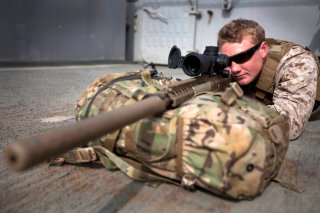Why the Marine Corps Is Over the MK-13 Sniper Rifle
The MK-13 is able to hit targets out to 1,250 meters.
Here's What You Need to Remember: Despite the MK-13’s not inconsiderable capabilities, it is slated for replacement in Marine Corps service by a rifle from Barrett. Barrett’s Multi-Role Adaptive Design, commonly known as the MRAD, is a hard-hitting, very versatile platform that can be chambered in 7.62x51mm NATO, .300 Norma Magnum and .338 Norma Magnum with conversion kits.
A bolt-action rifle, the MK-13 is the primary sniper rifle within specialized Marine Corps groups like Marine Corps Scout Sniper and Reconnaissance Platoons, as well as with MARSOC.
Prior to the MK-13, the Marine Corps had relied on the M40, a bolt action sniper rifle chambered in the 7.62x51mm NATO cartridge that has gone through multiple upgrades since introduction in the mid-1960s. Though sufficient when it was introduced, the rifle has since grown long in the tooth, and struggles to reliably hit targets beyond 900 meters, leaving Marine snipers literally outgunned in some long-range precision shooting situations.
In contrast to the M40, the MK-13 is able to hit targets out to 1,250 meters, according to United States Marine Corps informational material. The platform benefits from a folding stock that, when folded, reduces the rifle’s overall length by over 8 inches. The rifle can be tailored to fit a wide variety of shooters and features an adjustable butt plate, as well as adjustable cheek riser.
Though on its own, what is perhaps even more remarkable is the cartridge it is chambered in: the .300 Winchester Magnum.
The Ammunition
The .300 Winchester Magnum is a very versatile cartridge, and arguable one of the more popular .30 caliber rifle cartridges. It is noted for being a flat shooter—that is, it efficiently retains muzzle velocity, even at extended ranges, and in this regard outperforms a number of common rifle cartridges including the venerable .30-06 and 7.62X51mm NATO.
Given the .300 Winchester Magnum’s performance, it has proven to be a popular hunting cartridge and is sufficiently powerful to reliably take down a wide range of medium and large-sized game, including moose, black and brown bears, as well as virtually all African game animals.
In addition to enjoying a reputation as a powerful cartridge, the .300 Winchester Magnum has been favored by the police and military as an excellent sniper cartridge thanks to high long-distance accuracy and is in service with a number of Police departments throughout the United States and abroad.
Despite the MK-13’s not inconsiderable capabilities, it is slated for replacement in Marine Corps service by a rifle from Barrett. Barrett’s Multi-Role Adaptive Design, commonly known as the MRAD, is a hard-hitting, very versatile platform that can be chambered in 7.62x51mm NATO, .300 Norma Magnum and .338 Norma Magnum with conversion kits.
Postscript
Despite the MK-13’s eventual replacement, it nonetheless provided an important and significant upgrade over the Marine Corps’ Vietnam-era M40 sniper rifles. And more broadly, the MK-13 is part of a Marine Corps trend of quickly getting new, more effective and more lethal equipment quickly into Marine hands.
Caleb Larson is a defense writer for the National Interest. He holds a Master of Public Policy and covers U.S. and Russian security, European defense issues, and German politics and culture. This article is being republished due to reader interest.
Image: Flickr.

